|
National flag :
The symbol of Independence
by Rupa Banduwardena
  The national flag or Sinha Kodiya continues to flutter in homes,
shops, schools, temples, churches and other institutions to mark the
Independence of our paradise isle, especially after the dawn of peace
after three decades of turmoil, conflict and confusion. The national
flag was flown high on Friday in every nook and corner of Sri Lanka as a
symbol of true freedom. The national flag or Sinha Kodiya continues to flutter in homes,
shops, schools, temples, churches and other institutions to mark the
Independence of our paradise isle, especially after the dawn of peace
after three decades of turmoil, conflict and confusion. The national
flag was flown high on Friday in every nook and corner of Sri Lanka as a
symbol of true freedom.
The significance of the flag was truly felt on this landmark day. The
national flag showed the pride of freedom with the people of Sri Lanka.
When the first Parliament was inaugurated, the Duke of Gloucester
represented his brother King George VI of Britain and together with the
Dutchess were welcomed, at a royal ceremony, at the Independence Square.
At the proceedings, when the Duke read out the message, to officially
declare Lanka’s Independence, the first Prime Minister of Independent
Sri Lanka D.S. Senanayake hoisted the national flag which flew at high
mast amidst the blue sky, bringing tears of joy to those who watched the
lion flag flutter with a deep sense of pride and patriotism.
The historic first Independence Day celebrations is the first
occasion when the nation saluted, honoured and venerated the national
flag which stood as a monument of true freedom. The Lion flag which had
been used by the early royalty of Lanka went up majestically on the
flagstaff at Independence Square, signifying the independence of yet
another worthy crown colony of the Imperial Regime.
It was also hoisted at the Dalada Maligawa Octagon by the then Prime
Minister and a special perahera had been organised to mark the occasion.
The royal visitors too were present at the special function held, thus
the national flag flew high in Kandy too (the last bastion to fall)
amidst the sounds of Magul Bera and the chanting of Seth Pirith to
invoke blessings on the country.
Origin and history
The Vijaya episode has been the beginning of Lankan history. When
Vijaya, banished from his native land, arrived in Sri Lanka in 486 BC at
Tambapanni, he planted on the sea-shore a flag with a symbol of a lion
on it. Ever since, this symbol had played a vital role throughout the
history of Sri Lanka.
According to ancient chronicles, it had been widely used by the
subsequent kings as a symbol of freedom, unity and harmony.
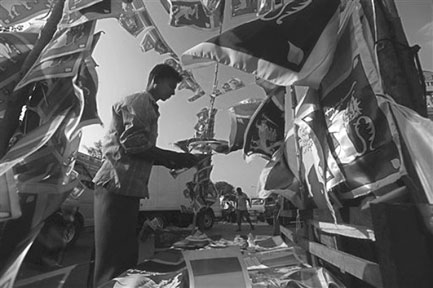 |
|
Brisk sales for the
national flag close to Independence Day |
E.W. Perera, a prominent figure in the freedom struggle, states in
his book that the three lions on the gateway of Sanchi Stupa have been
identified as the royal arms of Ceylon. The arch depicts the despatch of
the Bo tree to then Ceylon and the symbols on either side depict the
royal flags of Asoka and Devanampiyatissa. Even the Mahavihara, the
Buddhist Monastery at Anuradhapura, was laid out in the shape of a lion.
The Lion flag is considered the oldest national flag in the world.
Historically the lion flag of King Dutugemunu is said to be illustrated
in Cave 2 of Rangiri Dambulu Vihara which is supported by Professor
Anuradha Seneviratna in his book on the subject. It is said that
Dutugemunu’s flag has a lion and the sun and moon symbols. The flag of
the kings of Kotte is said to have had a lion. The Perakumba Siritha
composed during this period describes the flag with the lion fluttering
on the Northern ramparts, used by King Parakramabahu of Kotte.
E.W. Perera states in his book that an ola manuscript records that a
banner bearing the symbol of a lion holding a sword in the right paw was
the flag of Sri Wickrema Rajasinghe, the last king to rule the Kandyan
Kingdom, before it came under British rule. In 1815, they replaced the
Lion flag with the Union Jack as the national flag of Sri Lanka.
Sakyamuni Siddhartha Gautama Buddha, 2,600 years ago, had referred to
the use of flags in the Dhajagga Sutta and it is of very special
significance to Buddhists. The flag is the identity of a nation, country
and a kingdom. The flag is the reflection of a national and cultural
adaptation in its true perspective.
|
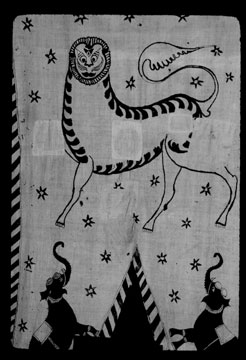 |
|
An ancient lion flag |
 |
|
The flag of King
Dutugemunu |
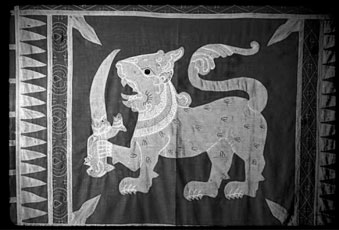 |
|
Kandy (Udapas Rata)
kingdom flag (1515-1597) |
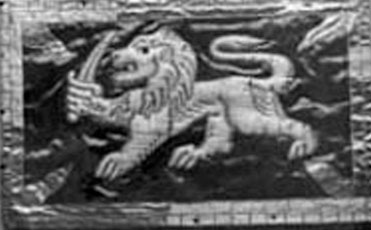 |
|
The 18th Century flag
of Kandyan kings |
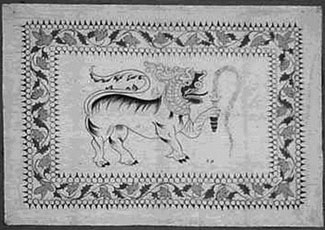 |
|
Flag of the Kotte
Kingdom |
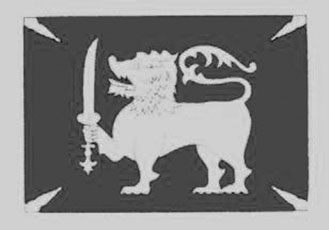 |
|
An old Lion flag |
“National sentiments are borne out in the flag. History reports that
the king was taken prisoner and deported to Vellore in South India, the
Lion flag was taken to England and kept at the Royal Military Hospital
in Chelsea. E.W. Perera among the galaxy of national leaders, who were
at the helm in the quest for freedom had discovered the original lion
flag at Chelsea. This was displayed in a special edition of the Dinamina
and this focused the attention of the entire nation. Unaware of the
former as to its actual design they were in great anxiety to see the
present flag.
The true national flag
The national flag of Sri Lanka was designed on the recommendations of
D.S. Senanayake, the Father of the Nation and the first Prime Minister.
This masterpiece in national tradition is unmatched and is sacred to the
entire nation. The national glory and culture is embodied very clearly.
Each feature has its own distinctive meaning and significance. The
brilliant crimson in the background indicates immortality. The gold
border running right round represent the Sangha who motivated and guided
the royalty. The four gold Bo leaves, at the four corners of the
background depict Metta, Karuna, Muditha and Upekkha - the four noble
qualities to be developed by humanity. The two equal vertical stripes in
saffron and green represent the Tamil and Muslim communities.
The picture of a lion in gold in the centre reflects the strength of
the nation while the gold sword held by the lion symbolises righteous
rule, justice and fairplay to all, heralding a time of peace and
harmony, for the welfare of all beings.
Our national flag is a symbol of Sri Lanka and its people. In short
it has a message for each citizen. Our original flag has seen many
changes over the years. History says that at one time, the royal flag
had a red lion holding a sword in the right paw on a white background.
However, regardless of the colours of the lion or the background, the
lion has adorned the flags of the kings of Lanka for over 20 centuries
and still continues to be the symbol of the national flag of Independent
Sri Lanka.
The existing flag since the dawn of independence is respected,
honoured and held in high esteem by every citizen of Sri Lanka. Hence,
it is revered in the country. With the passage of time, people have
become the rightful owners of the national flag - the 2,000-year-old
Lion flag belonging to a heroic, fearless and duty-conscious people of
Sri Lanka. It is a genuine symbol of unity.
|

